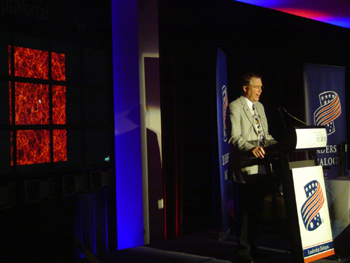Newsroom > News Release
Calit2 Director Engages Australian Universities and Policymakers about Intelligent Infrastructure for Scientific Discovery
 |
| Larry Smarr gives the Leadership Oration in Canberra with the AARNet OptIPortable next to him showing SDSC Chief Scientist Mike Norman’s cosmology supercomputer simulation. [Photo courtesy Nicole Bordes] |
|
San Diego, Nov. 19, 2008 -- Australia is fast shaping up to be a major partner with California institutions on large-scale, collaborative science projects following a unique initiative organized and led by the Australian American Leadership Dialogue (AALD).
That’s one of the conclusions reached by Larry Smarr, Director of the California Institute for Telecommunications and Information Technology (Calit2), after a three-week barnstorming tour of Australian universities and research centers as the 2008 Leadership Dialogue Scholar .
“Australia is clearly committed to implementing the bandwidth and collaborative tools originated by the OptIPuter project at Calit2,” says Smarr, a computer-science professor at the University of California, San Diego. “This sets up lots of new opportunities for collaboration between California and Australia in green IT, neurosciences, stem cells and many more fields.”
 |
| Larry Smarr, Phil Scanlan and Bernard Pailthorpe in front of the University of Queensland OptIPortal in Brisbane |
|
“Because of the 15 years of the Leadership Dialogue,” says Smarr, “Australia is the only country I know of that is pre-organized at the highest levels of government, the research sector and industry, giving it the capability of moving quickly to take advantage of this unprecedented opportunity to ensure Australia ’s increasing participation in innovative research worldwide.”
Phil Scanlan, founder of the AALD, recalls that the engagement with Larry Smarr through Calit2 in January 2007 led to this initiative.
“Larry has worked with us to identify drivers of sustainable, high community performance through 2050 and beyond,” Scanlan says. “Our best and brightest need access to global collaborators in their chosen fields of endeavor, and Larry has identified a systemic pathway to achieving this with the OptIPuter project as an early step.”
 |
| Dedication of Monash University's OptIPortal, showing confocal microscopy images in Melbourne. |
|
Smarr spoke at nine universities on “Coupling Australia’s Researchers to the Global Innovation Economy,” starting with the University of Adelaide on Oct. 2 and ending with a presentation at the University of Sydney on Oct. 17. His slides are available
online .
The high point of the visit came on Oct. 15, when the UC San Diego Jacobs School of Engineering professor delivered the Leadership Dialogue Scholar Oration to an audience of government and business leaders, diplomats, university officials, Members of Parliament and policy experts in the capital city of Canberra.
Smarr told policymakers that an innovation economy begins with the pull towards the future provided by a robust public research sector. He described a new global research platform to support data-intensive research which is rapidly arising parallel to the shared Internet.
 |
| Video link from the CSIRO OptIPortal in Canberra to a remote Australian developer of the Square Kilometer Array radio telescope |
|
This platform is a combination of dedicated fiber-optic lightpaths with bandwidth 100 to 1,000 times that of the normal Internet, scalable visualization walls for large-scale data analysis, and interactive high-definition video streams. The global research platform will be a key enabler for a goal of the Cutler review of the Australian innovation system, to wit: "To ensure a competitive economy for the 21st century, the Australian government should set a goal of making Australia the preferred partner for international research institutions."
Australia’s Academic and Research Network (AARNet), which provides up to 10 gigabits per second connectivity to research centers in Brisbane, Sydney, Canberra, Melbourne, Adelaide and Perth – i.e., tens of thousands greater bandwidth than typical broadband service available to households and corporations – is the critical backbone for this new research platform in Australia. (Smarr notes that Australia is competing to host the international Square Kilometre Array radio telescope, which specifies long-haul links one million times faster than standard broadband today.)
 |
| Study in Australian reforestation at the CSIRO OptIPortal dedication in Canberra |
|
“AARNet is supporting unprecedented levels of data transfer, collaboration and visualization with international partners,” notes Smarr. “This high-performance digital infrastructure is enabling the rapid Australian adoption of results from the U.S. National Science Foundation-funded OptIPuter global system, which removes bandwidth as an obstacle to data-intensive research by using dedicated fiber optics.”
Specifically, Smarr noted the growing adoption of OptIPortals – wall-sized visualization facilities with resolutions ten to 100 times that of a normal PC – which permit simultaneous videoconferencing and visualization of very large data sets. “When I addressed the Leadership Dialogue in August 2007, there were no OptIPortals in Australia; today there are seven,” he notes. “I have been visiting campuses across Australia and have been struck by the innovation shown by their researchers using these new technologies.”
 |
| Using AARNet to link Melbourne and Canberra showing the two OptIPortals at the University of Melbourne and Australian National University. |
|
Smarr’s visit was part of the Leadership Dialogue’s Project Link — the linking of Australia 's major research-intensive universities and the Commonwealth Scientific and Industrial Research Organization (CSIRO)
, Australia 's national science agency, to each other and to innovation centers around the world. At each university Smarr facilitated discussions about what is needed in the local campus infrastructure to make this ultra-broadband available to data intensive researchers.
Among the advanced applications Smarr observed on Australian campuses, most of which would not have been possible a year ago:
- The University of Melbourne has applications in drought management, drug design, and brain surgery.
- Scientists at the University of Queensland and U Melbourne interactively explored brain images on their respective walls and discussed their findings via a live, high-definition video link between the two OptIPortals.
- Researchers at the University of Western Australia in Perth discussed applications to gas, oil and mining industries.
-
 |
| Smarr and Phil Scanlan in front of ANU OptIPortal at dedication in Canberra |
|
At Monash University, cancer researchers demonstrated how the OptIPortal speeds up their research, while Monash computer scientists are pioneering high-definition video lectures by remote world experts to prepare their undergraduates for the 21st century global workplace.
- A Swinburne University radio astronomer used a dedicated AARNet fiber channel to a giant radio telescope in Parkes in western New South Wales, over 1,000 kilometers from the university in Melbourne. The ultra-high-speed link delivered his data in minutes, whereas he previously had to drive nine hours each way with a car full of data tapes to and from Parkes.
“This week at Supercomputing 08 in Austin, Texas, Australia, represented by the University of Queensland and AARNet, will be part of a pioneering experiment in real-time collaboration using fiber-connected OptIPortals in Australia, Korea, Japan, the Netherlands, the Czech Republic, Russia and the United States,” said Smarr. “The effect is to shrink the planet on demand, so we are all in the same room.”
 |
| Map of Australia indicating AARNet research bandwidth available between key cities; blue ovals indicate locations of October presentations by Larry Smarr. |
|
AARNet has a 10Gigabits-per-second (Gbps) backbone network, but hopes to expand that backbone to 100Gbps by the year 2012. Individual universities, in turn, aim to boost their on-ramps to AARNet to at least 40Gbps. But Smarr warned policymakers that many universities are still hampered by the lack of “last mile” end-to-end, high-performance bandwidth. Australia, he warned, also needs fiber to underserved areas such as Tasmania, Western Australia, the Northern Territories and coral reefs, all of which have important scientific instruments, but many of which today must rely on networking at less than 155 Megabits per second (see map).
Even with those shortcomings though, Smarr concluded that the country is uniquely positioned to “take advantage of this unprecedented opportunity to ensure Australia ’s increasing participation in innovative research worldwide.”
 |
|
Australian Media Coverage
Media interest in Larry Smarr’s visit to Australia was intense as he crisscrossed the continent. Even before arriving in Australia, Smarr (above, in Australian Financial Review) was interviewed by the Sydney Morning Herald and the Australian Associated Press (AAP) news agency. Articles about his forthcoming visit appeared in daily newspapers, including the Brisbane Times, Melbourne Herald Sun and online at News.com.au.
Here’s a roundup of articles that appeared in top Australian media outlets in October about Smarr’s visit as 2008 Leadership Dialogue Scholar and about the opportunities for Australia in driving innovation and global collaboration in scientific research:
Sydney Morning Herald, Sept. 29: “Speed up the net or get left behind,” by Jonathan Pearlman
News.com.au, Oct. 2: “Universities need Internet overhaul,” by Australian Associated Press
FutureGov.com, Oct. 8: “Australian Universities Must Upgrade Network to Keep Up,” by Amelia Kwok
Australian Financial Review, Oct. 13: “Call for ultra-fast network,” by Ben Potter
The Australian, Oct. 15: “Develop the backbone for new era,” by Andrew Trounson
The (Melbourne ) Age, Oct. 18: “Beginning to see the light,” by Nick Miller
Australian Financial Review, Oct. 18-19: “Innovation the key to a smart economy,” by Larry Smarr
|
|
“We have been most encouraged by the visit of Professor Smarr,” says Chris Hancock, AARNet CEO. “AARNet’s goal is to provide Australia with a world-class network, so that researchers here are able to collaborate on an equal footing with colleagues worldwide. We are delighted to have someone of his stature endorse this strategy. We believe his visit is also providing a vital stimulus to the collaborations necessary to combine high-speed networks, high- performance computation and high-resolution visualization in a way that is crucial to so much research today. This will enable our researchers to participate in leading-edge fundamental science, and to tackle some of our most pressing global problems, like finding new treatments for cancer and AIDS, and avoiding environmental disasters.”
In an Oct. 20 white paper submitted to the Leadership Dialogue, Smarr also urged Australia to continue investing in the “intelligent infrastructure” that will be critical to competing on a global scale. “There exists a unique opportunity to leverage the great intellectual and technical capital of Australian universities and the private sector to create a 21st century digital ‘intelligent’ civilian infrastructure, built on fiber optics, sensornets and advanced information technologies,” Smarr explains. “Forward-looking countries are moving rapidly to this new paradigm — and those that don’t will be left behind.”
In the paper distributed by the Leadership Dialogue to lawmakers and other key constituencies, Smarr spelled out four potential applications for intelligent infrastructure: infrastructure monitoring, transportation, education, and homeland security.
He also made three recommendations to policymakers, urging them to:
- Allocate a designated percentage of “aggregate nation-building infrastructure investments” to embedding intelligence in physical infrastructure;
- Designate a portion of those investments to the public research sector to drive innovation by basic and applied research; and
- Award funding to industry-academic partnerships to create “distributed geographic testbeds to develop, deploy and evaluate intelligent infrastructure prototypes.”
Phil Scanlan says that Smarr’s paper on intelligent infrastructure has worldwide application.
 |
| Dedication of the Australian National University OptIPortal in Canberra showing surface of Jupiter’s moon Io |
|
“Larry’s recommendations on intelligent infrastructure resonate beyond Australia and the United States to organizations active in nation-building and reconstruction in the developing world," observes Scanlan. "In this 21st century every dollar allocated toward infrastructure must be made to really count and deliver optimum benefits.”
“Last January, as part of the second West Coast Leadership Dialogue, the University of Melbourne deployed the first OptIPortal in Australia and it opened up a pathway for collaboration between UC San Diego and Melbourne,” recalls Smarr. “So even before my October visit, it was clear to me that the Australian audience would be receptive to Calit2’s vision of networked, collaborative science, but the reaction to my visit was even more constructive than I could have predicted.”
Related Links
Larry Smarr Presentations in Australia
OptIPuter/OptIPortals
Australian American Leadership Dialogue
CSIRO
AARNet
Media Contacts
Doug Ramsey, 858-822-5825, dramsey@ucsd.edu










